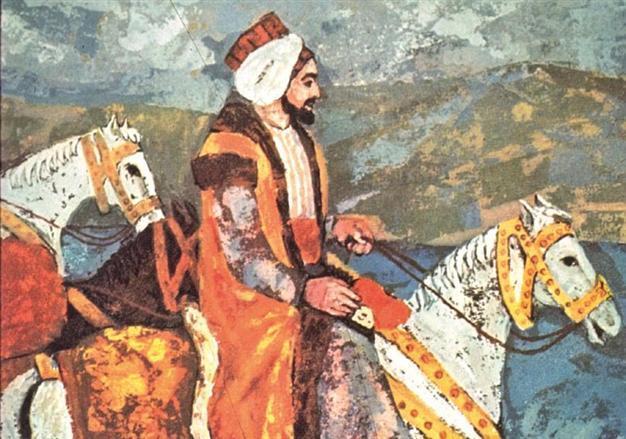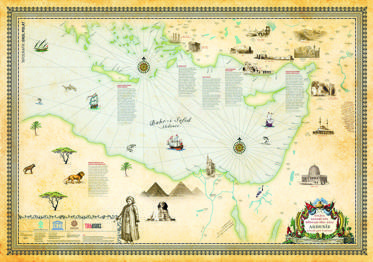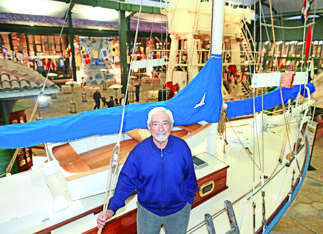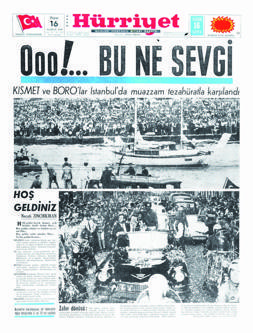Remembering two historic journeys
Emrah GÜLER

While Evliya Çelebi started and finished his travel alone, the Boro family was welcomed by thousands on their return, making the headlines. The boat is currently displayed at Rahmi Koç Museum.
Three centuries apart, renowned travelers began their journeys from the land that is now Turkey - two journeys that would both go on to make history. In 1630, the Ottoman Turk Evliya Çelebi began his journey in the Ottoman Empire and its surrounding lands, which would last 40 years and be documented in his travelogue Seyâhatnâme. In 1965, Sadun Boro began his own famous journey, becoming the first Turkish sailor to globetrot with his boat Kısmet.
Coming from a wealthy family and educated in court, Evliya Çelebi began his travelogue long before he began his journey of four decades. He began by recording his fascination with the architecture and culture that defined 17th century Constantinople. The Seyâhatnâme eventually turned into a 10-volume work of some of the earliest travel writing, taking in Constantinople, Anatolia, the Caucasus, the Middle East, Russia, the Balkans, Greece, Egypt and Sudan.

While Seyâhatnâme borders on fiction with exaggerated accounts in many parts, Evliya Çelebi’s notes remain a crucial guide to the period, encompassing a crucial portion of the known world in the 17th century. All 10 volumes have never been translated into English, but the longest single English translation, Evliya Efendi, was published in 1834 by the Austrian orientalist Ritter Joseph von Hammer-Purgstall. The translation includes parts from the first two volumes, covering Constantinople and Anatolia.
Detailed analyses of Evliya Çelebi and his Seyâhatnâme have been carried out in 21st century by some scholars, the most prominent being Robert Dankoff, a professor of Turkish and Islamic Studies at the University of Chicago. An Ottoman Mentality: The World of Evliya Çelebi, published by BRILL in 2004, is the most comprehensive study of Evliya Çelebi and the Seyâhatnâme. There is also a near-complete translation into German by Erich Prokosch.
 Sailing across the globe with Kısmet
Sailing across the globe with KısmetExactly three centuries after Evliya Çelebi was traveling and writing about Austria and the Crimea, which would make up the bulk of the seventh volume of his travelogue, another traveler began his own journey across the sea. Sadun Boro set sail with his wife Oda from Istanbul in August 1965 with his 10.5-meter boat Kısmet, picking up their famous cat Miço in the Canary Islands for a journey around the globe.
The journey would last two years and 10 months, navigating a route through Gibraltar, the Canary Islands, the Caribbean, the Galapagos Islands, the Fiji Islands, Singapore, Bengal Bay, Ceylon Island, the Arabic Sea, the Red Sea, and Israel, before arriving back in Istanbul in June 1968. The couple, along with their eight-year-old daughter Kısmet Deniz (meaning sea), later set sail on another journey, traveling around the globe in two years and three months.

Boro first recounted his travels in daily Hürriyet, later compiling them in his book “Pupa Yelken: Kısmet’in Dünya Seyahati” (Full Sail: Kısmet Traveling across the Globe), published in 1969. The later prints include a 35-minute CD of recordings of the Boro couple during their journey. The famous globe trot wasn’t the first open sea journey for Boro. In 1953, at the age of 24, he had sailed in his 11-meter boat Ling from England to the Caribbean Islands with a British companion. His memoirs of this journey were published in Turkey in 2004, under the name “Bir Hayalin Peşinde” (Following a Dream). Two other travelogues written by Boro are also available in Turkish.
The famous boat Kısmet was donated by Sadun Boro to the Navigation Collection of the Rahmi M. Koç Museum in Istanbul’s Haliç Shipyard. If you visit the museum, you can also see another famous boat, actually a yawl, Uzaklar (Far Away). Uzaklar was the yawl that another couple, Osman and Zuhal Atasoy - inspired by Boro family’s journey - used to globetrot. Setting sail in 1990, the couple sailed across the globe in four years and ten months, and Uzaklar became the smallest Turkish craft ever to circumnavigate the globe. Happy travels to all globetrotters - as well as those settling for less.

 While Seyâhatnâme borders on fiction with exaggerated accounts in many parts, Evliya Çelebi’s notes remain a crucial guide to the period, encompassing a crucial portion of the known world in the 17th century. All 10 volumes have never been translated into English, but the longest single English translation, Evliya Efendi, was published in 1834 by the Austrian orientalist Ritter Joseph von Hammer-Purgstall. The translation includes parts from the first two volumes, covering Constantinople and Anatolia.
While Seyâhatnâme borders on fiction with exaggerated accounts in many parts, Evliya Çelebi’s notes remain a crucial guide to the period, encompassing a crucial portion of the known world in the 17th century. All 10 volumes have never been translated into English, but the longest single English translation, Evliya Efendi, was published in 1834 by the Austrian orientalist Ritter Joseph von Hammer-Purgstall. The translation includes parts from the first two volumes, covering Constantinople and Anatolia. Sailing across the globe with Kısmet
Sailing across the globe with Kısmet Boro first recounted his travels in daily Hürriyet, later compiling them in his book “Pupa Yelken: Kısmet’in Dünya Seyahati” (Full Sail: Kısmet Traveling across the Globe), published in 1969. The later prints include a 35-minute CD of recordings of the Boro couple during their journey. The famous globe trot wasn’t the first open sea journey for Boro. In 1953, at the age of 24, he had sailed in his 11-meter boat Ling from England to the Caribbean Islands with a British companion. His memoirs of this journey were published in Turkey in 2004, under the name “Bir Hayalin Peşinde” (Following a Dream). Two other travelogues written by Boro are also available in Turkish.
Boro first recounted his travels in daily Hürriyet, later compiling them in his book “Pupa Yelken: Kısmet’in Dünya Seyahati” (Full Sail: Kısmet Traveling across the Globe), published in 1969. The later prints include a 35-minute CD of recordings of the Boro couple during their journey. The famous globe trot wasn’t the first open sea journey for Boro. In 1953, at the age of 24, he had sailed in his 11-meter boat Ling from England to the Caribbean Islands with a British companion. His memoirs of this journey were published in Turkey in 2004, under the name “Bir Hayalin Peşinde” (Following a Dream). Two other travelogues written by Boro are also available in Turkish.